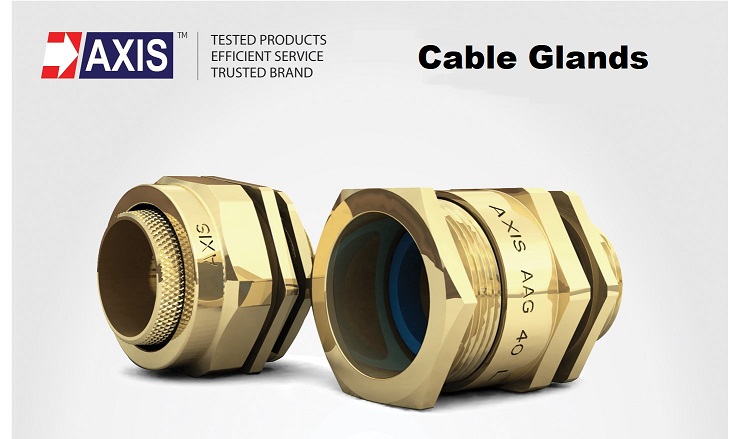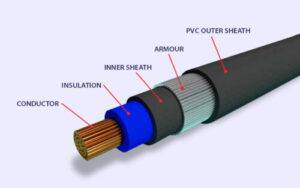Cable Gland is the ‘mechanical cable entry device’ attached to the end of electrical cables and secures them to any piece of equipment. They are also commonly known as cable connectors, cable fittings, cord grips, or cable strain reliefs.
Cable Glands are vital for terminating cables in harsh or hazardous areas where sealing and ingress protection is required. These are very important for electrical equipment and switch gears as they offer strain relief and can also be connected to the aluminium sheath or armour of the cable.
As mechanical cable entry devices, cable glands can be constructed from metallic or non-metallic materials. Cable glands are necessary across many industries, which use these in conjunction with cable and wiring used in electrical instrumentation and automation systems. They are used on the cable of all available sizes and types. Its primary role is to safely pass a tube, wire, or cable through an enclosure. However, they are also required to protect electrical parts from flames that may take place in hazardous areas.
Purpose of Cable Glanding:
As mechanical fittings, they form part of the electrical installation. They are used to strengthen the attachments of cables with the electrical equipment to which the cable is attached. They protect:
1) The entrance out of the equipment from dust
2)From being twisted at the connecting point to the equipment
These glands are for all types of electrical power, control, instrumentation, data, and telecommunications cables. As a sealing and termination device, they ensure that the characteristics of the enclosure through which the cable enters can be properly maintained.
Why do you need Cable Glands?
For cable management, the cable gland serves multiple roles for protecting the attached cable equipment.
What kind of protection do they provide?
- They provide Earthing, grounding, bonding, insulation, and strain relief.
- They seal cables that pass through bulkheads or gland plates.
- They can prevent external contaminants such as dirt, dust, or fluid and contain an electrical spark or a flame.
- Stop the cable from becoming pulled or twisted is within the cable gland’s remit.
How does Cable Glanding work?
It works as a sealing device that protects the enclosures on electrical equipment. Additionally, they act as a seal to the ingestion point and stop impurities from outside to cause any damage to the electrical system and the cable. Environmental contaminations like dirt, fluid, or water cause damage to the cable joints and may also cause them to disjoin from the electrical parts. Therefore, cable glands stop cables from being pulled and twisted out of the machine.
Cable Glands Usage:
Earth continuity in an armoured cable. If the cable gland has a metallic construction that requires testing to ensure its ability to withstand any strong short-circuits or fault currents.
On a cable, it acts as a holding force ensuring only an adequate level of resistance is allowed.
Provides environmental protection by sealing the outer cable sheath by assuring that dust or water can reach the enclosed area.
Offers additional levels of sealing to parts of installations where there is a need for high ingress protection.
Provides additional environmental sealing at the cable entry point that maintains the ingress protection rating of the enclosure.
There are multiple options to choose cable glands as they are manufactured based on the environments where they will be installed.
Factors considered for Cable Glands:
1) Is it going to be used indoors or outdoors?
2) Is it going to be used in an explosive or hazardous environment or a safe industrial zone?
3) Will it be installed in a place where the surroundings are dusty or damp?
4) Is there any presence of corrosive materials or gases nearby?
5) Is it suitable for the size and type of cable used?
Depending on the answers to these questions, the cable glands are selected. The protective coating or plating on the glands is also manufactured based on these factors.
Types of Cable Glands based on the above questions:
Single Compression: For the inside of buildings and smaller installations.
Double Compression: For power plants and factories that require strong seals. These cable glands have double sealing and double-compression application at the cable core and on the outer sheathing or armour.
Flexible Hose: For locations with higher temperatures.
PVC: For control cables attached to instruments.
The single and double-compression cable glands have three additional types to be used as per requirement:
- Light-duty
- Weatherproof
- Flameproof
Armoured Cable Glands: Armoured cable glands or armoured cables are used with steel-wired armoured (SWA) cables, the standard cable for underground and wall cabling installations. The steel mesh protects the cable from damage.
Waterproof Cable Glands: They offer IP68 waterproofing, i.e. they can resist immersion in water of one metre or more depth. They use the International Protection (IP) standard ─ the standard marker for resistance to water, dust, and other contaminants.
Metal Cable Glands: These cable glands are made of stainless steel, and aluminium. They offer a range of benefits:
Stainless Steel: They offer good corrosion and pressure resistance.
Aluminium Glands: They are flexible and rust-resistant and also conduct good heat and electricity.
Brass cables: They are the age-old choice that offers strength and resistance to magnetism and deformation at high and low temperatures. It also provides good electrical conductivity. We specialize in brass cable glands that are used universally, and it is the best choice for the construction and power industry and other industrial areas. The six types of brass cables have different uses like:
- Indoor ─ these are good for cables, including armoured, plastic, and rubber-sheathed.
- Outdoor ─ these are useful with plastic or rubber-sheathed and unsheathed cables.
- Straightening ─ these are beneficial with rubber-sheathed and unsheathed cables and can be used in indoor and outdoor applications.
- Weatherproof ─ these are used with plastic or rubber sheathed cables. They hard-built and provide a strong seal having a variation designed for maximum water resistance.
- Threaded ─ threaded glands are custom-made for use in fixed industrial applications.
- Industrial ─ Mainly used with plastic or rubber sheathed and with armoured cabling.
Rubber Cable Glands: Some types of them have watertight seals. These seals are manufactured from synthetic rubber. Chloroprene is the material in making O-rings, a circular gasket that forms a sturdy seal. Neoprene is used for washers, like flat sealant rings.
Axis Electrical India specializes in high-quality brass indoor and outdoor Cable Glands. These are tested and certified as per IEC 62444 and BS 6121 standard from TUV Rheinland. These are highly suitable for all types of unarmoured cables, plastic or rubber sheathed cables. They provide a seal on the outer sheath. Use of PVC shroud with it will provide additional ingress protection.
Thank you for reading the blog, Axis is a leading manufacturer and supplier of Electrical Components to over 80+ Countries. To get a quote or to talk to our industry expert visit our contact us section. You can also watch our videos by our experts – click here.








